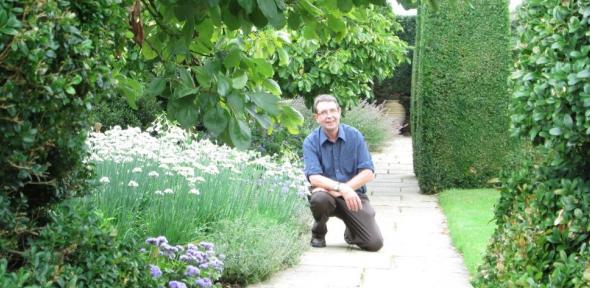
The Open Cambridge team caught up with Paul Gallant to find out what life is like as Head Gardner at Selwyn College, which is part of the Bridge the Gap walk route this year.
OC: How long have you been Head Gardener of Selwyn College? During this time, what’s changed in the garden?
PG: I’ve been Head Gardener at Selwyn for 14 years now. Previously, I worked at three other Cambridge colleges earlier in my career. The main changes at Selwyn have been around the new building of Ann’s Court (first phase was completed in 2005, second phase was completed in 2009) and the recent refurbishment of Cripps Court. Ann’s Court was an opportunity to design a new garden from scratch. We’ve added more trees and shrub borders to Cripps Court, Old Court gardens and the lower gardens have been updated, altered and enhanced over the years.
OC: What do you enjoy most about your job? And what are the main challenges?
PG: I really enjoy the variety of challenges that the gardens present, and keeping everything running to a high standard with help from my invaluable team. The weather has presented us with some interesting challenges recently – we were mowing the lawns in December and January this year as they just kept growing through the warm winter; it’s the first time I’ve seen this in over 40 years of gardening. Growing unusual plants for the Victorian style border is something I particularly enjoy.
OC: In what way is working for a College different to other jobs you’ve had?
PG: It has a better set-up in terms of the infrastructure – the greenhouses, equipment, etc – and on the management side the Garden Committee is always appreciative of the work my team and I do. Also, I enjoy seeing the great pleasure that our gardens give to visitors, students and fellows and the fact that our gardens are used for studying by our students as well as those from the nearby Sidgwick Site.
OC: Can you tell us a little bit about the history of the garden?
PG: Not too much is documented about the gardens, but I believe all the previous Head Gardeners have contributed greatly to the way the garden is now and how it has evolved over the past 130+ years. Originally, the lawn in Old Court was sunken, like that of our sister college Keble in Oxford, and was filled in during the mid-1960s. During the Second World War, Old Court Lawn was used to grow hay and the lower lawn was a vegetable allotment. The Fellows’ Garden was a coal store, and chickens were kept in the area behind C and D staircases.
OC: Which are the star plants in the garden?
PG: The Holm Oak in the lower garden, the Elm tree in the library car park (a rare survivor of Dutch Elm disease) and the Cedar of Lebanon in front of Ann’s Court are believed to all date back to late Victorian times, as is the Virginia Creeper in Old Court.
OC: How would you characterise the garden?
PG: It has a natural and somewhat random flow to it, which gives it great character and enhances its charm. There is always something to see in the garden, especially in the spring, but it has great interest throughout the year.
OC: What big plans do you have next for Selwyn garden?
PG: There are plans for further new buildings in Ann’s Court; these will require new gardens designed around them. Plus, ongoing improvements to the current gardens as there are plenty of existing borders that have scope for future work.
OC: In your opinion, what makes the garden so special and what should Bridge the Gap walkers look out for?
PG: The garden is an inspiring place to walk through; different areas each have their own character and plantings. The Victorian style border gives good colour and structure to the garden later in the year, right up until the first frosts – this is a time when many gardens are devoid of colour and interest.

